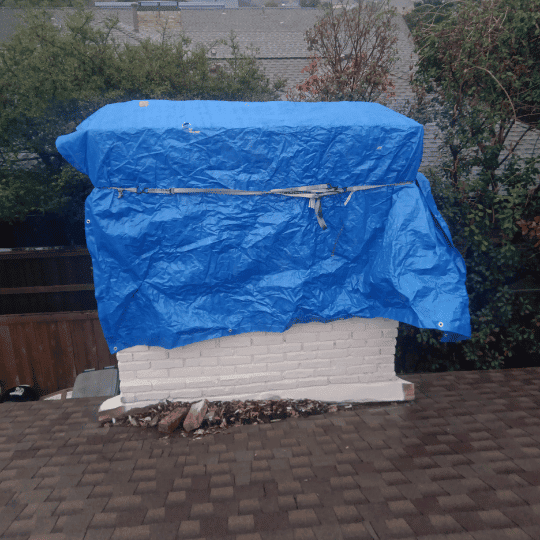A leaking chimney can lead to mold, rotting framing, damaged walls and ceilings, and more if left unchecked. Chimney leaks most often originate from a handful of common problem areas like the crown, flashing, or deteriorated mortar joints. This article will cover the likely sources of chimney leaks, how to pinpoint where water is entering your chimney, and the proper repair techniques to stop the intrusion for good. We’ll also provide tips on how regular chimney maintenance can help reduce your risk of leaks during severe weather. Arm yourself with the right inspection and repair knowledge so you can catch chimney leaks early and avoid destruction to your home.
Do chimneys leak in heavy rain?
No, it is not normal for chimneys to leak during heavy rain if they are properly constructed and maintained. A well-built chimney with a chimney cap, an intact flashing, a weatherproof crown, and sound mortar joints should be able to withstand heavy downpours without leaking. Leaks coming from your chimney during rainstorms usually indicate there is some kind of deficiency or damage to the chimney that requires chimney leak repair.
Some common reasons chimneys may leak when it rains heavily include:
- Deteriorated or missing mortar between bricks or stones. This allows moisture to seep through gaps in the masonry.
- Missing chimney cap. A cap sits on top of the chimney crown and provides additional protection from rainfall. If the cap is damaged or absent, more water can enter the flue.
- Cracked, crumbling, or nonexistent chimney crown. The crown functions like a cap, diverting water away from the chimney. Without it, rainwater can pour directly into the flue.
- Damaged, poorly installed, or missing flashing around the chimney. Flashing provides a waterproof barrier where the chimney meets the roof. Holes or tears in the flashing can allow leaks.
- Accumulated debris and obstructions in the flue. This can force water that enters the flue to leak through the masonry instead of properly draining.
- Age and normal wear and tear over many years. Chimneys can simply deteriorate over time, developing cracks and weak points.
While heavy rain can exacerbate existing issues, a properly constructed chimney should not leak under normal circumstances. If your chimney develops leaks during storms, be sure to have it inspected and repaired by a professional chimney contractor, like Masters Services Chimney & Masonry, as soon as possible.
Where do chimneys usually leak from?
Chimneys usually leak from a few common areas:
- The chimney crown – This is the top, flat surface on the chimney. Cracks, crumbling concrete, or deterioration in the crown allow water to seep directly into the chimney flue. Lack of a crown or a poorly constructed one makes leaks more likely.
- Mortar joints – The mortar between bricks or masonry units can weaken and erode over time from exposure to weather. When this mortar washes out, gaps form where water can intrude during rains.
- Flashing – Flashing provides a waterproof joint where the chimney meets the roof. Cracked, rusted, or missing flashing sections are prime locations for leaks.
- The chimney cap – A cap sits on top of the crown and deflects water. A damaged, poorly fitted, or missing chimney cap can lead to leaks if rain gets into the flue opening.
- Inside the flue – Obstructions like bird nests or excessive creosote buildup can force water that enters the flue to leak back out through damaged masonry rather than draining properly.
- Near the fireplace – Leaks may occur at the damper or transition area between the fireplace and flue, particularly if the flashing in this area is compromised.
Thoroughly inspecting all sides of the chimney during a rain storm can help pinpoint exactly where it is leaking. Then necessary repairs like repointing brick, replacing flashing, or installing a new chimney crown can address the problem areas.
What to do if your chimney is leaking?
If you notice your chimney leaking, it’s important to have it inspected and repaired as soon as possible to prevent further damage. Here are some steps to take:
- Look for visible signs of leaks during a rain storm. This can help pinpoint the source, whether it’s the crown, flashing, joints, or another area.
- Have a professional chimney contractor inspect the full exterior and interior of the chimney. They can identify the exact cause and location of any leaks.
- Repairs may involve repointing mortar, replacing damaged sections of flashing, installing or replacing the chimney crown, or clearing blockages. The right solution depends on where the leak is originating.
- Consider having a chimney cap installed if one is not present. Caps provide extra protection from moisture infiltration.
- For serious leaks, full reconstruction of the chimney crown, flashing, or other areas may be required.
- Be sure all repairs are completed by an experienced, licensed chimney professional to ensure proper code compliance and fix any underlying issues.
Professional Chimney Leak Repair Specialist
Don’t ignore a chimney leak or just cover it up with a temporary patch. Contact the chimney repair experts at Masters Services Chimney & Masonry to inspect and properly repair leaking chimneys for Dallas, Houston, and Oklahoma City area homes. Our technicians have the experience to diagnose and fix any chimney water damage.
